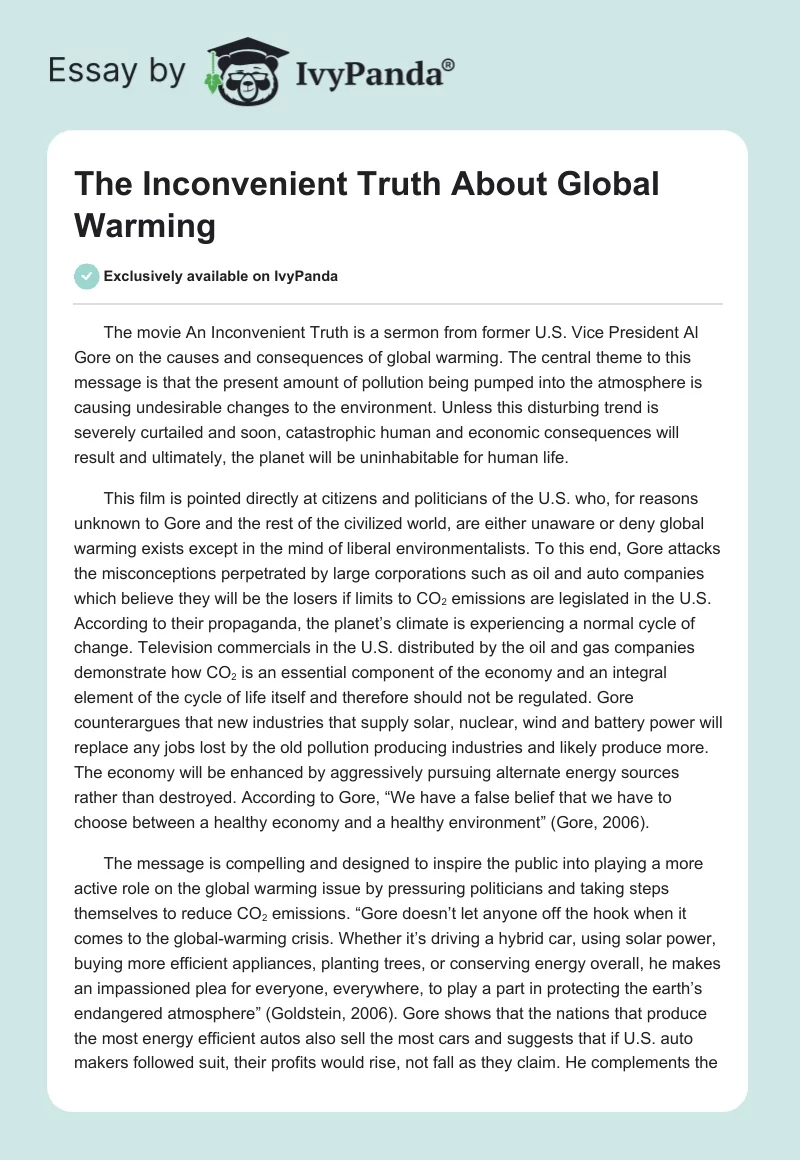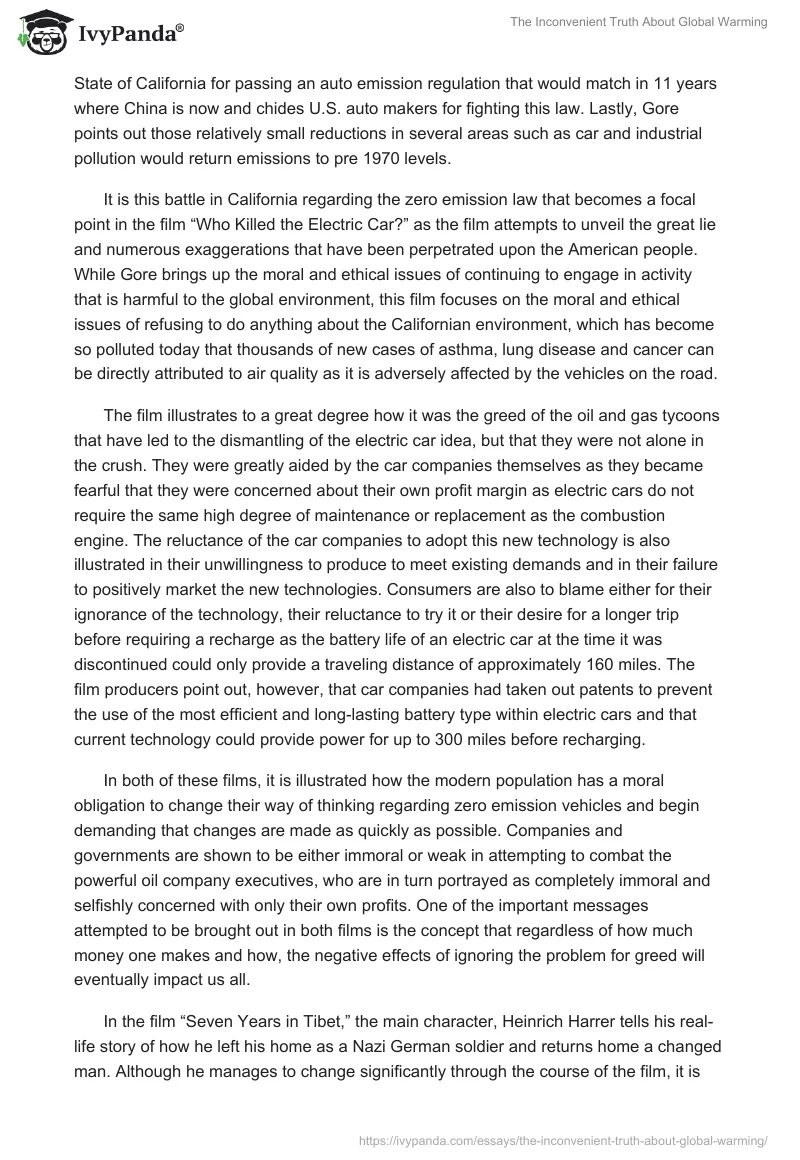The movie An Inconvenient Truth is a sermon from former U.S. Vice President Al Gore on the causes and consequences of global warming. The central theme to this message is that the present amount of pollution being pumped into the atmosphere is causing undesirable changes to the environment. Unless this disturbing trend is severely curtailed and soon, catastrophic human and economic consequences will result and ultimately, the planet will be uninhabitable for human life.
This film is pointed directly at citizens and politicians of the U.S. who, for reasons unknown to Gore and the rest of the civilized world, are either unaware or deny global warming exists except in the mind of liberal environmentalists. To this end, Gore attacks the misconceptions perpetrated by large corporations such as oil and auto companies which believe they will be the losers if limits to CO2 emissions are legislated in the U.S. According to their propaganda, the planet’s climate is experiencing a normal cycle of change. Television commercials in the U.S. distributed by the oil and gas companies demonstrate how CO2 is an essential component of the economy and an integral element of the cycle of life itself and therefore should not be regulated. Gore counterargues that new industries that supply solar, nuclear, wind and battery power will replace any jobs lost by the old pollution producing industries and likely produce more. The economy will be enhanced by aggressively pursuing alternate energy sources rather than destroyed. According to Gore, “We have a false belief that we have to choose between a healthy economy and a healthy environment” (Gore, 2006).
The message is compelling and designed to inspire the public into playing a more active role on the global warming issue by pressuring politicians and taking steps themselves to reduce CO2 emissions. “Gore doesn’t let anyone off the hook when it comes to the global-warming crisis. Whether it’s driving a hybrid car, using solar power, buying more efficient appliances, planting trees, or conserving energy overall, he makes an impassioned plea for everyone, everywhere, to play a part in protecting the earth’s endangered atmosphere” (Goldstein, 2006). Gore shows that the nations that produce the most energy efficient autos also sell the most cars and suggests that if U.S. auto makers followed suit, their profits would rise, not fall as they claim. He complements the State of California for passing an auto emission regulation that would match in 11 years where China is now and chides U.S. auto makers for fighting this law. Lastly, Gore points out those relatively small reductions in several areas such as car and industrial pollution would return emissions to pre 1970 levels.
It is this battle in California regarding the zero emission law that becomes a focal point in the film “Who Killed the Electric Car?” as the film attempts to unveil the great lie and numerous exaggerations that have been perpetrated upon the American people. While Gore brings up the moral and ethical issues of continuing to engage in activity that is harmful to the global environment, this film focuses on the moral and ethical issues of refusing to do anything about the Californian environment, which has become so polluted today that thousands of new cases of asthma, lung disease and cancer can be directly attributed to air quality as it is adversely affected by the vehicles on the road.
The film illustrates to a great degree how it was the greed of the oil and gas tycoons that have led to the dismantling of the electric car idea, but that they were not alone in the crush. They were greatly aided by the car companies themselves as they became fearful that they were concerned about their own profit margin as electric cars do not require the same high degree of maintenance or replacement as the combustion engine. The reluctance of the car companies to adopt this new technology is also illustrated in their unwillingness to produce to meet existing demands and in their failure to positively market the new technologies. Consumers are also to blame either for their ignorance of the technology, their reluctance to try it or their desire for a longer trip before requiring a recharge as the battery life of an electric car at the time it was discontinued could only provide a traveling distance of approximately 160 miles. The film producers point out, however, that car companies had taken out patents to prevent the use of the most efficient and long-lasting battery type within electric cars and that current technology could provide power for up to 300 miles before recharging.
In both of these films, it is illustrated how the modern population has a moral obligation to change their way of thinking regarding zero emission vehicles and begin demanding that changes are made as quickly as possible. Companies and governments are shown to be either immoral or weak in attempting to combat the powerful oil company executives, who are in turn portrayed as completely immoral and selfishly concerned with only their own profits. One of the important messages attempted to be brought out in both films is the concept that regardless of how much money one makes and how, the negative effects of ignoring the problem for greed will eventually impact us all.
In the film “Seven Years in Tibet,” the main character, Heinrich Harrer tells his real-life story of how he left his home as a Nazi German soldier and returns home a changed man. Although he manages to change significantly through the course of the film, it is difficult to say whether he has attained the goal of wisdom as it is set forth by Erik Erikson. He has reflected upon his life and found a means of reconciling with the decisions of his past, as is shown in his reunion with his son, but there is no real means of determining whether or not he achieves the sense of satisfaction and fulfillment Erikson alludes to simply in his action of planting the flag at the top of a mountain with his son looking on.
As the story begins, Harrer is shown to be a very arrogant, selfish young man with little or no regard for others. He drags his pregnant wife through a crowded train station with no concern about her unhappiness at having to face giving birth to a child alone with her husband gone or realizing that he may be risking her health in the haphazard way in which he incautiously drags her through the crowd. He gripes the entire time about his dislike for the man placed in charge of his expedition, Peter Aufschnaiter. He doesn’t even show much loyalty to the Nazi party as he reluctantly takes the flag in 1939.
As the expedition gets underway, Harrer’s selfishness is exacerbated by pride and a dangerous sense of ‘manliness.’ As they make their way up Nanga Parbat, the mountain they have determined to climb, Harrer falls down and hurts his leg. His pride won’t permit him to tell anyone of his accident, the pain he’s suffering or the danger he is placing the group in as a result because if he tells anyone, he may be sent back down the mountain and not be a part of the triumphant group that will eventually reach the top. That Harrer’s pride is getting in the way of the safety of the group is made clear as his damaged leg nearly costs Aufschaiter his life. As it turns out, no one reaches the top of the mountain because an avalanche forces them to turn back and, upon reaching the bottom, they discover Germany has declared war and they, as Germans, are immediately captured and put into war camps by British soldiers.
Perhaps the first indication that Harrer is beginning to grow as a person comes after he has received divorce papers from his wife, made several escape attempts from the British war camp, stolen food from a religious offering in India and suffered food poisoning as a result, cheated Tibetian guards and convinced Aufschnaiter, who has rejoined him, to trade a highly prized watch for food. It is after the two men have managed to escape into the mountains again that Aufschnaiter discovers Harrer had several valuables that could have been traded for food without having risked the one-of-a-kind watch he himself gave up and Harrer begins to demonstrate signs of remorse and growth. He begs Aufschnaiter to forgive him and offers him all of his watches as well as his wedding ring to try to repay him as Harrer realizes that he didn’t deserve the wife either. From this point on, Harrer begins to seriously consider the life path that he’s taken to this point and to evaluate it.
According to Erik Erikson, this is the first step of the final stage of human development and is usually not reached until a person reaches age 60-65 as this is the time when the children are grown and gone and the individual finally has a chance to sit back and reflect upon their life as they prepare for death. The late adult period is characterized by self-evaluation and the results of those conclusions. Erikson characterizes the older adult as an individual who must resolve the ego integrity vs. despair crisis in which the individual must either accept their failures and successes in life to develop a sense of wisdom or those who cannot accept their disappointments and develop a sense of despair and dread regarding their coming death (Niolon, 2007). It is perhaps because of the precarious position Harrer finds himself in that he begins this process somewhat earlier than most.
Although Harrer has begun the process, he has by no means attained wisdom such as that Erikson discusses in his theory. This is shown as Harrer continues to try to win the love of the Tibetian tailor by stories of his exploits and demonstrations of his physical prowess. His ego is obviously fully intact and his resentment over others is still in full swing when he visits the newly married Aufschnaiter and the tailor, Pema Lhaki. This concept of himself is further deflated when his son, Rolf, back in Germany, writes to ask him to stop sending letters, effectively shutting Harrer out of his life forever. When he becomes the tutor of the Dalai Lama, he also becomes the taught as he begins to learn the lessons of peace and humility. When the trouble with China begins, he is seen as a comfort and a support for the young Dalai Lama and, perhaps more importantly, is seen to have changed his attitude toward life. He is no longer the arrogant, proud young man with no loyalties except to himself. He has managed to find the watch that he forced Aufschnaiter to give up for food and returned it to him as a gift and he quickly condemns Jigme for his nearly traitorous actions in so quickly surrendering to the Chinese upon their invasion of Tibet.
When Harrer finally returns to Germany following the fall of Tibet, he manages to become reunited with his son because of the patience and wisdom he has learned on his journey. Rather than forcing the boy to accept him, Harrer has learned the value of respect for independent thought and leaves Rolf alone to make his own decisions. The film ends with Rolf and Harrer climbing an unnamed mountain. As they reach the peak, Harrer plants a Tibetian flag, illustrating his loyalty to the ideals he learned there and acknowledging the wisdom he’s gained.
Works Cited
An Inconvenient Truth. (2006). Al Gore. Lawrence Bender Productions.
Niolon, R. “Erikson’s Psychosocial Stages of Development.” Resources for Students and Professionals. PsychPages, (2007). Web.
Seven Years in Tibet. (1997). Dir. Jean-Jacques Annaud. Perf. Brad Pitt, David Thewlis, Danny Denzongpa. Applecross films.
Who Killed the Electric Car. (2006). Chris Paine. Sony Pictures.


